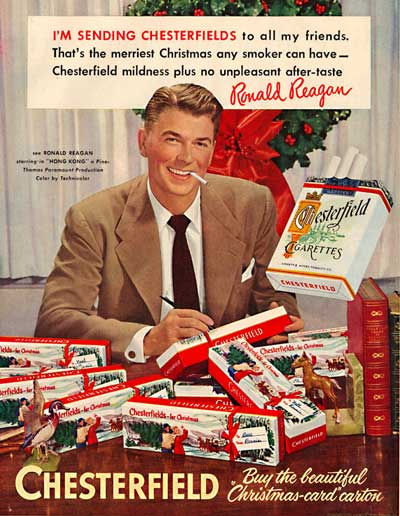The Health Risks Associated with Vaping

October 14, 2016
Have you thought about what you’ll give your friends and family this holiday season?
I’m sending e-cigarettes to all of my friends. That’s the merriest Christmas anyone can have- a healthful alternative to tobacco cigarettes plus no unpleasant smells.
If Ronald Reagan were around, and still an actor, he would have endorsed that message. He promoted Chesterfield cigarettes in a similarly-worded advertisement in 1949, claiming that they were a more “mild” form of cigarette.
The tobacco industry used deceit, misinformation and outright fabrications when they advertised products to consumers. Companies such as Lucky Strike, Camel, and Marlboro deliberately misled the public for decades during the 20th century about the health costs associated with smoking cigarettes. In the wake of increasingly disconcerting research, lawsuits, and government regulation the tobacco industry’s prevalence has been reduced- from 27.5% of American high school students smoking in 1991 to just 9.3% by 2015. This promising trend is projected to continue going forward; however, a sinister force that threatens to undermine the progress made against tobacco’s widespread use has recently emerged . They are the manufacturers of electronic cigarettes (commonly called e-cigarettes), who have capitalized on the decline of smoking to advance their products.
E-cigarettes consist of a multitude of devices that resemble tobacco products, including e-pipes, e-hookahs, and e-cigars; collectively, they are termed electronic nicotine delivery systems (ENDS). They use a heating element- powered by a battery- to aerosolize an e-cigarette liquid from a reusable cartridge. Inhaling the vapors of this liquid, which can contain nicotine, propylene glycol, and flavorings, is called vaping. E-cigarettes essentially deliver nicotine to the body without producing smoke, unlike traditional cigarettes. ENDS have been available in the US since 2008; they have been advertised as a healthier alternative to normal cigarettes and viable option to help quit smoking. It is true that e-cigarettes do not burn tobacco (they heat a nicotine extract from tobacco leaves), and therefore cannot produce tar. Compared to conventional cigarettes, E-cigarettes are indeed less harmful. However, e-cigarettes present their own array of health risks that have short-term and long-term effects on the body. The primary concern is nicotine; the highly addictive drug is a cardiovascular stimulant and can exacerbate pre-existing heart conditions. Nicotine also adversely affects fetal development and brain development in adolescents; it will have these effects regardless of the method that is used to deliver it.The chemical propylene glycol also presents a concern- especially when it is heated- due to its tendency to degrade into formaldehyde, which causes nose and eye irritation while increasing the risk of developing asthma and cancer. Their use as a tool to facilitate cessation of smoking is also dubious, and the FDA has not officially approved of it. Companies may be inclined to falsely claim that their products help smokers quit, in order to categorize themselves as a therapeutic product and escape stricter regulation by the FDA. E-cigarette users are often “dual users,” or smoke both traditional and electronic cigarettes; 70-90% of the ENDS-using population may belong to this category. A non-smoker who uses e-cigarettes increases their risk of becoming addicted to conventional cigarettes.
A huge danger intrinsic to continued e-cigarette availability and mass marketing is introducing vaping to a younger demographic. $115 million is poured into advertising in a deliberate and calculated move by the e-cigarette industry to get members of the teenage population dependent on their products. The methods used today to advertise e-cigarettes are highly similar to those used to market tobacco to a younger consumer base years ago (namely, associating the product with rebellion and independence). Nearly 70% of American students- representing a figure in excess of 18 million middle schoolers and high schoolers- are exposed to these ads. This can be correlated with a sharp rise in vaping by high schoolers, going from 1.5% in 2011 to 16% in 2015. The slow emergence of regulatory legislation serves to compound this problem; it was only in August this year that the FDA extended their oversight to e-cigarettes. Teenagers who become addicted to nicotine predispose themselves to further drug addictions later in life.
Another risk posed by vaping arises from the flavorings used in ENDS. Nearly 7,700 flavors exist and are used in the products of a multitude of manufacturers. Some are used to entice teenagers, including such varieties as cherry, vanilla, and bubblegum. Aside from their addictive lure, flavors in e-cigarettes carry another danger: the chemical diacetyl. Diacetyl is known to cause bronchiolitis obliterans, or “popcorn lung”- the scarring of the alveoli (air sacs) in the lungs. Despite this link, the chemical is found in several e-cigarette flavors; 39 out of 51 tested brands were reported to contain it.
Today America is faced with a new threat to public health- that of ENDS and their increasing popularity. The skyrocketing usage of e-cigarettes comes amid advertisement campaigns that misinform or directly lie to the public, and target the youth of the nation to produce a new generation of addicts. Under the guise of safety and healthfulness, the e-cigarette industry has firmly established itself and continues to grow rapidly. Hundreds of companies have formed in states across the country, and vape lounges that hearken back to the days of smoke lounges have sprung up in cities throughout the nation. These concerning developments make you wonder: has anything really changed since Reagan endorsed those Chesterfield cigarettes in 1949?











